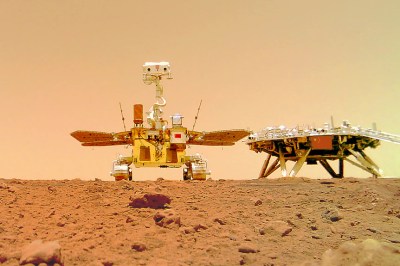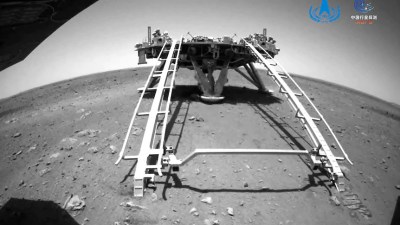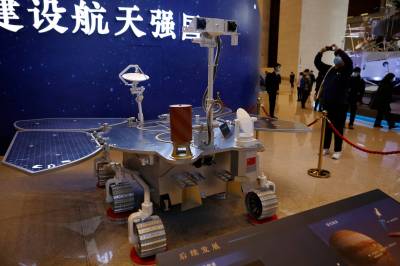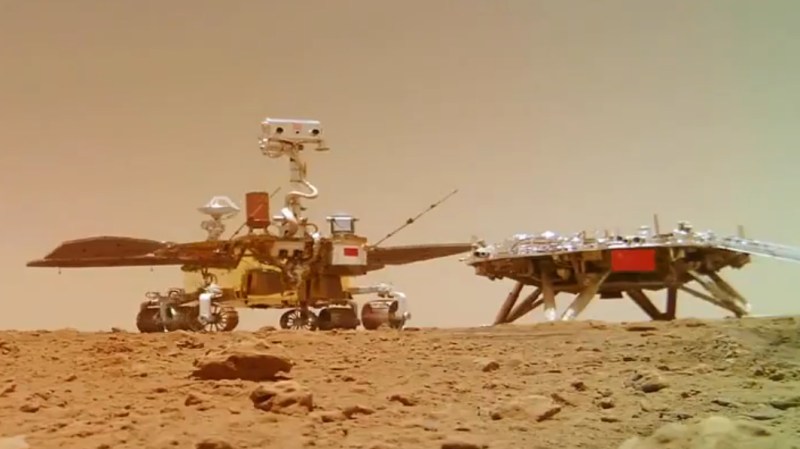China’s space program has big goals and is already starting to achieve them. Recently, the China National Space Administration has landed its first rover on Mars, and begun to explore the surface of the red planet.
It’s a huge step, and something only previously achieved successfully by NASA. Let’s take a look at the Chinese project, its goals, and see how it compares to the American rovers that have also roamed so far away.
Wheelin’ on Mars

China’s first Mars rover goes by the name of Zhurong, named after a figure in Chinese mythology that is typically associated with fire. Given that Mars is known as the “Planet of Fire” in China, it’s a fitting name selected by a public vote held earlier this year.
The rover comes in at a size of 2.6 meters long, 3 meters wide, and 1.85 meters high, with its size placing it in between NASA’s Mars Exploration Rovers which landed in 2004, and the later Curiosity rover which is a touch larger. The Zhurong rover weighs 240 kilograms, again placing it in between the two recent generations of NASA Mars rovers.
Zhurong was launched as part of the Tianwen-1 mission which launched on July 23, 2020. The spacecraft entered Martian orbit on February 10, 2021, with the lander touching down on 14 May 2021 in the Utopia Planitia. The area on Mars was chosen as an ideal spot to investigate the possibility of the planet being host to an ancient ocean. The descent was controlled by parachutes and retro-rockets which slowed the lander as it approached the surface.
What Lies Beneath

The rover sports a sensor package designed to perform a variety of science missions. Chief among those is the ground-penetrating radar, designed to collect geological data and capable of imaging up to 100 meters below the Martian surface. This goes far deeper than the 10 meter depth capability of the instrument fitted to the Perseverance rover which landed earlier this year. There’s also a magnetometer onboard for determining the finer details of Mars’s magnetic field.
Atmospheric data is captured by measuring temperature, pressure, wind velocity and direction in the Martian atmosphere. There’s also a microphone which captures sound, which tends to have a different quality to that on Earth due to the different atmospheric conditions.
Analysis and Imaging Hardware
Similarly to other rovers, a laser-induced breakdown spectroscopy instrument is included. For those who aren’t deeply involved in the spectroscopy subculture, this is a device which blasts rock and other samples with a laser and measures the emitted light. This can be used to determine the chemical makeup of samples.

Camera-wise, a multi-spectral camera is fitted which aims to research the details around the existence of water on Mars. There are also extra cameras specifically intended for navigational purposes and for mapping out the topography of the surrounding area. These are key to the rover’s mission, as communication time delays from Earth to Mars make direct teleoperation of the rover impossible. Cameras are instead used to enable the rover to take some level of autonomy in getting around its immediate area.
Some of the rover’s science hardware is eclipsed by that present on Perseverance, such as the fancier spectrometers on board, but overall it’s a very complete science package. Zhurong’s primary goals of studying Martian geology and soil, as well as the atmosphere, should reveal useful insights into the makeup of Mars as well as its history.
One unique feature of the rover is its active suspension system. Unlike the passive rocker-bogie suspension system used on NASA rovers, Zhurong has fully independent control of each wheel’s suspension. It can adjust the weight placed on each wheel, which could be particularly useful if the rover finds itself encountering softer soils, and could also assist in navigating obstacles or steeper slopes.
The Mission Thus Far
China has recently released images of the rover on Mars, taken by a selfie camera that was dropped for that very purpose. The images document Zhurong rolling away from the camera as it begins to explore its landing site. Thus far, the rover has spent over a month on Mars, and has travelled 236 meters since landing. It is expected to spend 90 days studying the Martian surface, though it’s common for rover missions to be extended if the hardware continues functioning past the original timeline. As an example, NASA’s Opportunity rover ended up exploring the planet for 14 years despite originally being intended to operate for just 90 days.
The video released of the rover and its lander don’t show a lot of action yet, but we look forward to more images and more science coming out of the project. More rovers on Mars can only mean more learning, though we’re a touch disappointed that thus far, they’ve all landed far apart and don’t get to hang out. Perhaps one day, two rovers will meet; for now, with only six on the Martian surface, that’s likely quite some time away!
















” More rovers on Mars can only mean more learning, though we’re a touch disappointed that thus far, they’ve all landed far apart and don’t get to hang out.”
Demolition Derby on Mars!
Only One Will Win!
B^)
“Rover Wars” :-)
Robot wars
Robot Jox
Just wait until we (Europe) finally get there, roundabouts everywhere !!!
marslander. there can be only one.
“a fitting name selected by a public vote”?
I’m very disappointed they didn’t go for “羅孚麥克羅弗臉”
Thanks for helping me expand my Chinese vocabulary :)
Business idea: A Mars solar panel cleaning company/service.
Hear me out.
The company has *one* asset: a Mars blimp (much like the perseverance helicopter). Or maybe two for redundancy/once the business model is shown to work.
It’s launched along with any Mars mission that lands a rover/lander on the surface (like Curiosity/Opportunity/the Chinese one) to reduce cost/so we don’t have to develop landing systems
Once on the surface, we inflate the blimp with 02 we make from the ambient CO2 (Sabatier process). Perseverance is doing this right now, we do a super-miniaturized version of that.
As O2 is lighter than CO2, the blimp floats. We test it in the same chamber as they tested the Mars helicopter, they’ll let us do it for free, because this is a cool project.
The top of it is made of flexible solar panels, so we get plenty of power, which means we can fly several kilometers a day, possibly even at altitudes at which Martian winds won’t bother us too much. At the bottom is a propulsion/battery/system that allows it to orient and move in the direction it needs to go.
If our solar panels get too much (ironic) sand on them, we do a barrel roll, problem solved. Or we bump in the side of a Martian rock with a forward-facing pole custom-designed for this task, and the shock causes the sand to fall off.
It uses the propulsion/floating to go to customer sites: rovers/landers with sand-covered solar panels like if Opportunity was still around, we’d go there.
Or we’d go to Insight, it’s the perfect example: it’s currently on Mars, and it’s currently not getting as much power as it could due to sand on its panels.
Once we get to a customer site, we use a mini compressor to pressurize a small canister with very high-pressure CO2 (it’s all miniaturized, we want to get a few dozen milliliters of maybe 20bar CO2, enough for a small burst that’s big enough to remove some sand, but with a *very* lightweight pump and canister).
We use this mechanism (or maybe also a rotating brush, probably possible/cheap enough to have several mechanisms as backups) to work on the solar panel until it’s completely free of sand, and the lander/rover is getting all of its solar energy.
Once we’re done cleaning, we move to our next site/target (that is, if the customer pays. If the customer doesn’t pay, we just park the blimp on top of the customer’s lander, keeping it in the shade, so it doesn’t get solar power, until we are paid, with an extra late fee, MUAHAHAHAHAHAHA),
Next customer could be thousands of kilometers away, doesn’t matter, we are a blimp, let’s just float there. During the day we float at top speed in the right direction, and at night if the wind pushes us in the right direction, we let it, and if it doesn’t, we anchor to the ground.
And the various space agencies (NASA, JAXA, ESA, Chinasa) pay us for the cleaning services: Space Janitor Blimp !!!
We have lots of potential customers.
It’s worth a lot of money for them because it extends the life of their missions, which is much cheaper than sending new stuff up there, so we can be paid millions of dollars for each cleaning job, and over time probably make a profit (assuming it was cheap enough to send the thing there in the first place. Probably the cheapest prospective option right now is to go with one of the planned SpaceX Starship Mars test missions that are planned for 2022/2024).
Doesn’t this sound cool ?
Who wants to invest a few millions into this? (I promise to take lowest-5-percentile salary)
We can probably finance like half the project just from having a “Nike” or “Coca-Cola” logo on the side of the blimp.
I’m broke (who would have guessed, the guy with the crazy Mars business idea can’t finance it himself, needs your kopecks), but I can totally do like 1% of the engineering of this, and write proposals/specs to try to get state agency funding from somewhere.
I can even do like 90% of the engineering for an earth-bound demo version of this that could go deliver bursts of air to simulated Mars environments built in school gymnasiums or something.
If you want to be sure that I’m motivated: I really need this to work and make money off it, because I need the money to finance my project for a giant 3D printer that 3D prints giant kilometer-sized transparent domes for Mars habitats.
I’m the guy behind smoothieware.org not just some rando, also.
Come on Elon, I know you read hackaday, ping me. wolf.arthur@gmail.com !!!
why not simple wipers, transparent wind deflectors, piezo mounted panels, and/or flipping panels ?
I keep emailing them to ask them to add all this stuff every time a solar-powered thing ships to Mars, they keep ignoring me and adding no dust-counter-measures.
So now, they have to pay *ME* so I send my blimp to fix *their* mess, that wouldn’t be a mess if they had listened.
MAYBE I’ll send my blimp to help, if I feel like it.
Numbers? How much are you guessing such a craft could/should/would weigh, and how much volume would it need to fill to displace its own weight? Seems like that would be a major factor for a lighter-than-air craft, in an atmosphere of such low density. Also, sure, CO2 is pretty dense, but O2 isn’t that much less dense, so my wild-ass guess is that it would have to be kind of large.
I have no idea how much it would weigh. It doesn’t *need* to weigh much (the payload at least) to do its job, but I haven’t done any of the math for Mars-based blimps.
I’ll start doing that once I have free time to do the math, and i’ll have free time to do the math only once I get investors to give me money :)
If floating O2 in CO2 doesn’t work, we could pack along He or H2, or get the H2 from the ambiant water vapor in the athmo, or get that water from a “drilling for water” experiment from the rover the blimp would rideshare to mars with, or grab some dust from the wind/ground and do some chemistry to that to extract what we need (likely hydrogen atoms) progressively to compensate loss, or capture traces of CH4 and break that down to get H2. As you can see, there are lots of options here :)
https://en.wikipedia.org/wiki/Atmosphere_of_Mars is pretty interresting read
Or maybe having a very large blimp is fine, that’s a possibility too. Lower gravity, low density athmo, etc.
Or we invent a techno that has zero loss of He over time (or close enough that it is the same as if it was zero), and we just inflate with He we take along with the blimp.
One interresting thing is, maybe a very big blimp *is* a good idea/thing and not a disadvantage: the bigger the more surface, and presuming we can make the actual surface/shell out of a material that is also solar panels ( hello graphene and friends ), that might mean a lot of power produced, and we can then use propellers to push the thing upwards (and forwards)
Y’all might run into a wall as in Van Der Waal’s force holding fine dust that sticks and may even bond to the surface. Moon dust was a problem, Mars dust will be a problem.
It would be cool if a rover met another rover and sent us the pictures!
For now: https://www.uahirise.org/hipod/ESP_069665_2055
And love was born as their shovels met in the sand.
For now, they have already overtaken Russia and the European Union in space robotics.
I prefer the terms “standing on the shoulders of giants” or “technology development”, you sound like a kid crying out “they stole my idea”.
I think they spend a bit above 0 in R&D, and its great that we enter an new space race era.